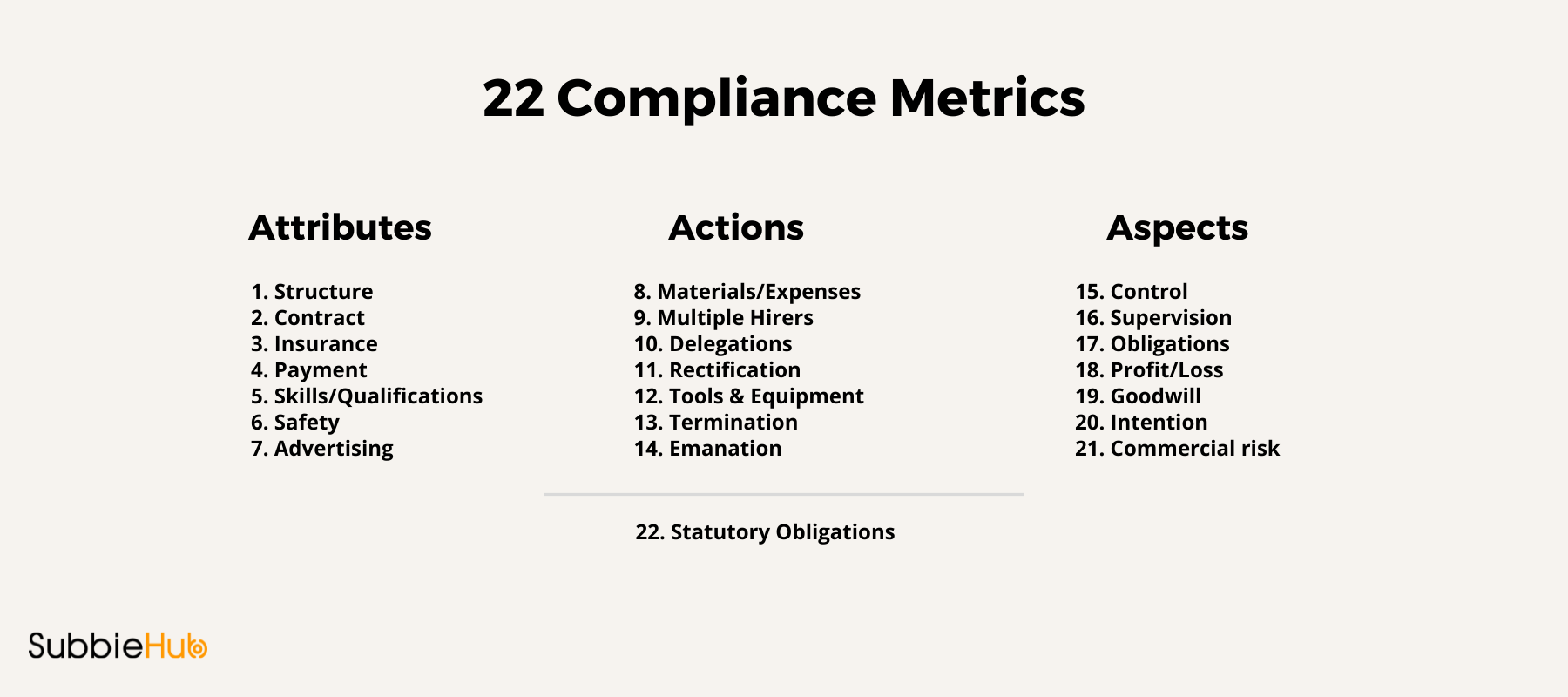Compliance when you are engaging subcontractors seems to be a daily requirement and a never ending job when it comes to staying on top of your obligations. Being compliant is a broad term that covers a very wide range of legal responsibilities, so how do you know where you really stand?
The key to having a clear overview of your contractors compliance, is to use metrics to test each of your subcontractors against, on an ongoing basis. The metric is simply what you are trying to measure, for example, is the contractor insured or not? By using a metric with a yes or no, we can now measure many contractors at the same time against a pre-set list of questions or ‘metrics’. This is what we call a metric-driven approach to compliance.
A metric driven approach is about measuring each individual subcontractor against a set of questions to better understand their compliance. Only then can you say with confidence, yes all my contractors meet their compliance requirements.
What is a Metric Driven Approach?
In a metric driven approach, we are identifying all the different aspects that go into a subcontracting relationship and breaking them down into individual steps. By doing so, we remove the confusion that often comes from trying to answer a question like “are your contractors compliant?”. It is unlikely you are going to be able to answer a question like that off the cuff, but a question like “does your contractor have a public liability insurance certificate?” is far easier to answer.
The result of addressing each individual question is that you will get a great high level overview of where your compliance is tracking with each individual subcontractor. Taking this approach does three very powerful things:
- Forces you to collect the physical documentation you need to show proof of compliance.
- Identifies gaps in your documentation that you may not be aware of.
- Highlights your greatest weaknesses for achieving compliance.
Taking a metric driven approach will save you enormous amounts of time and money by focusing on what you can improve internally before engaging specialist professionals to assess your business.
The best way to think of a metric driven approach is as a heat gauge, with each metric providing a notch on your gauge that will give you a single point of reference to review your subcontractor relationships.
22 Compliance Metrics
Subcontracting comes in all shapes and sizes which makes it difficult to address compliance when there are so many moving pieces. To overcome this challenge we have developed a set of questions or metrics that can be applied to any contracting scenario.
Our metrics are based on legal principles that have been used in previous decisions by the courts to determine the nature of a contracting relationship (it’s called the ‘common law’). Almost all pieces of legislation contain one or more description based on these common law principles and they form the basis for which many laws have been built from.
After reading countless court decisions, we have distilled down a set of 22 metrics that can be used to measure the compliance of a contracting relationship. These metrics are not exhaustive, as the list of tests used by the courts over time would be far too overwhelming. However, this set of 22 metrics is the most comprehensive set of tests we have come across in the Australian landscape.

Some of these metrics are very simple, such as what is the structure of the business you are engaging, others such as safety, are more complex. In each metric, you are trying to gauge what you have documented, what the reality of the engagement is and where responsibility lies if something goes wrong.
Evidence is King
Because we use such a comprehensive set of metrics, we get to paint a vivid picture of the relationship you have with the worker you are engaging. A key point of using these metrics as a measurement tool, is that you must be able to prove your answer to each metric with physical evidence. I can’t tell you how many times I have asked a business owner if the subcontractor has their own insurance, the answer is normally always yes. When I ask can I see a copy of their certificate of currency that details their insurance, there are a lot less people that I would fit into the yes category.
Evidence comes in many forms and may be simpler than you think to collect. The primary goal here is to be able to support your answers with physical evidence of some description. Not all evidence is created equal and the act of having to produce documentation will allow you to review the quality of the evidence that you can produce for any given aspect of the relationship.
Applying the Metrics to Legislation
In Australia, there is a long list of legislation that affects subcontracting such as tax law, superannuation law, work, health and safety laws, workers compensation and much more. Each of these laws can be applied to contracting arrangement and each law needs to be followed with strict compliance.
Metric number 22 is ‘Statutory Entitlements’, that metric is specifically drawing your attention to the fact that these metrics need to be applied to each individual piece of legislation. The beautiful part of measuring compliance using these metrics is that if you have done the work to put them together, they can be applied largely as they are to each piece of legislation. Similarly, if you have all your documentation in place covering these 22 metrics, you will save a lot of time and money taking your situation to a legal professional to provide advice on whether you are meeting your obligations.


